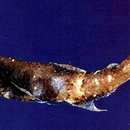Migration
provided by Fishbase
Oceanodromous. Migrating within oceans typically between spawning and different feeding areas, as tunas do. Migrations should be cyclical and predictable and cover more than 100 km.
Morphology
provided by Fishbase
Dorsal spines (total): 0; Dorsal soft rays (total): 11 - 13; Analspines: 0; Analsoft rays: 16 - 18
- Recorder
- Cristina V. Garilao
Biology
provided by Fishbase
Oceanic (Ref. 4066), found between 275-1,000 m during the day; between 40-275 m at night with maximum abundance between 50-100 m (Ref. 4479). Mesopelagic (Ref. 5951).
Comprehensive Description
provided by Smithsonian Contributions to Zoology
Lampanyctus alatus
This is a moderately large species, growing to 61 mm (Hulley, 1981); maximum size in the Ocean Acre collections is 54 mm. Lampanyctus alatus tentatively is classified as a tropical species and is listed as one of the ranking myctophids in the North Atlantic subtropical region (Backus et al., 1977), but the Ocean Acre collections do not confirm this. The species is uncommon in the study area, and is represented in these collections by only 80 specimens; 29 were caught during the paired seasonal cruises, 13 of which were taken in discrete-depth samples, of which 10 were in noncrepuscular tows (Table 23).
DEVELOPMENTAL STAGES.—Juveniles were 21–37 mm, subadults 33–51 mm, and adults 43–51 mm SL. There was no obvious external sexual dimorphism in fish of any size. All but two adults were males. One of the females contained ova up to 0.5 mm in diameter and appeared to be ripe or nearly so. None of the large (over 40 mm) subadult females appeared to be spent.
REPRODUCTIVE CYCLE AND SEASONAL ABUNDANCE.—The reproductive status of this species in the Ocean Acre area is uncertain. Although a large ripe or nearly ripe female was taken, juveniles smaller than 18 mm were not. Individuals smaller than 30 mm SL account for less than 10 percent of the total number taken in the Ocean Acre area. This scarcity of small juveniles in the collections may indicate that recruits into the population were mostly larger fish that were spawned elsewhere. In any case, L. alatus was never very abundant in the study area (Table 81), and any spawning must be at a low level.
Fish larger than 40 mm were taken most of the year, and small fish (less than 30 mm) were taken in very low numbers in April and from July through October. These data imply a relatively long breeding season for the parent population.
VERTICAL DISTRIBUTION.—Day depths in winter (based on 3 specimens) are 701–850 m and in late summer (1 specimen) 751–800 m. Nocturnal depths in late spring (5 specimens) are 51–100 m and 251–300 m, and in late summer (1 specimen) 201–250 m (Table 81).
- bibliographic citation
- Gibbs, Robert H., Jr. and Krueger, William H. 1987. "Biology of midwater fishes of the Bermuda Ocean Acre." Smithsonian Contributions to Zoology. 1-187. https://doi.org/10.5479/si.00810282.452
分布
provided by The Fish Database of Taiwan
分布於世界三大洋熱帶及亞熱帶海域。臺灣則發現於西南部、東部及東沙群島等周邊水域。
利用
provided by The Fish Database of Taiwan
一般以底拖網捕獲,不具食用經濟價值,通常做為下雜魚用。
描述
provided by The Fish Database of Taiwan
體細長,側扁,後部略細。頭略大。吻短,前端突出。眼大。口大,上頜骨狹長而延伸至前鰓蓋後緣,末端略擴大;上下頜、鋤骨、腭骨均具齒帶。體被大而薄圓鱗,易脫落;側線平直。背鰭單一,位於體中部,具軟條11-13(通常為12),後部另具一脂鰭;臀鰭基底長於背鰭基底,具軟條16-18(通常為17);胸鰭細長,末端達臀鰭前部,軟條數11-13(通常為12);尾鰭叉形,尾鰭副鰭條堅硬而呈棘狀。各部位之發光器位置於下:眶前發光器(Ant)無;鼻部背位發光器(Dn)無;鼻部腹位發光器(Vn)小而圓形,周圍具黑色組織;眶下位發光器(So)無;頰部發光器(Cp)1個,位於頰部中央;鰓蓋位發光器(Op)2個,位於前鰓蓋後緣下方,Op1明顯較Op2小,均在眼眶下緣縱線之下;胸鰭上方發光器(PLO)1個,距側線比距胸鰭基部近;胸鰭下方發光器(PVO)2個,兩者幾互為垂直排列;胸部發光器(PO)5個,PO4位置昇高,位置約等高於PVO2;腹部發光器(VO)4個,排列呈凸出的小弧形;腹鰭上位發光器(VLO)緊臨側線;臀鰭上方發光器(SAO)3個,三者排列呈鈍角狀,SAO3在側線下緣;體後側位發光器(Pol)2個,在脂鰭下方,二者與最後的AOa排成一斜線;臀鰭前部發光器(AOa)5-6個,除AOa1稍下凹外,餘呈水平排列;臀鰭後部發光器(AOp)6-7個,沿尾柄腹側排列;尾鰭前位發光器(Prc)4個,前三個水平排列,緊連於AOp後,Prc4則在Prc3的前上方,緊臨側線下緣。尾部發光腺SUGL具2-4個及INGL具4-5個小覆瓦狀發光鱗,周圍具黑色組織不深。此外脂鰭基部前方另具一發光腺。
棲地
provided by The Fish Database of Taiwan
大洋性中層巡游魚類,具日夜垂直分布習性,白天一般棲息深度可達275-1,000公尺左右,晚上則上游至水深40-275公尺附近處覓食,其中以50-100公尺間水域豐度最高,以小蝦等甲殼類為食。
Lampanyctus alatus
provided by wikipedia EN
Lampanyctus alatus is a species of lanternfish.[1][2] It is found in parts of the Atlantic, Indian, and Pacific Oceans. It grows to 6.1 cm (2.4 in) standard length.[1]
References

- license
- cc-by-sa-3.0
- copyright
- Wikipedia authors and editors
Lampanyctus alatus: Brief Summary
provided by wikipedia EN
Lampanyctus alatus is a species of lanternfish. It is found in parts of the Atlantic, Indian, and Pacific Oceans. It grows to 6.1 cm (2.4 in) standard length.
- license
- cc-by-sa-3.0
- copyright
- Wikipedia authors and editors
Diet
provided by World Register of Marine Species
Feeds on zooplankton
North-West Atlantic Ocean species (NWARMS)
- license
- cc-by-4.0
- copyright
- WoRMS Editorial Board
Distribution
provided by World Register of Marine Species
Western Atlantic: Canada to Gulf of Mexico, lesser extent in Caribbean and North Sargasso Seas, isolates from Brazil to Argentina
North-West Atlantic Ocean species (NWARMS)
- license
- cc-by-4.0
- copyright
- WoRMS Editorial Board
Habitat
provided by World Register of Marine Species
oceanic, found between 275-1,000 m during the day; between 40-275 m at night with maximum abundance between 50-100 m
North-West Atlantic Ocean species (NWARMS)
- license
- cc-by-4.0
- copyright
- WoRMS Editorial Board
Habitat
provided by World Register of Marine Species
nektonic
North-West Atlantic Ocean species (NWARMS)
- license
- cc-by-4.0
- copyright
- WoRMS Editorial Board
Habitat
provided by World Register of Marine Species
Known from seamounts and knolls
Stocks, K. 2009. Seamounts Online: an online information system for seamount biology. Version 2009-1. World Wide Web electronic publication.
- license
- cc-by-4.0
- copyright
- WoRMS Editorial Board

